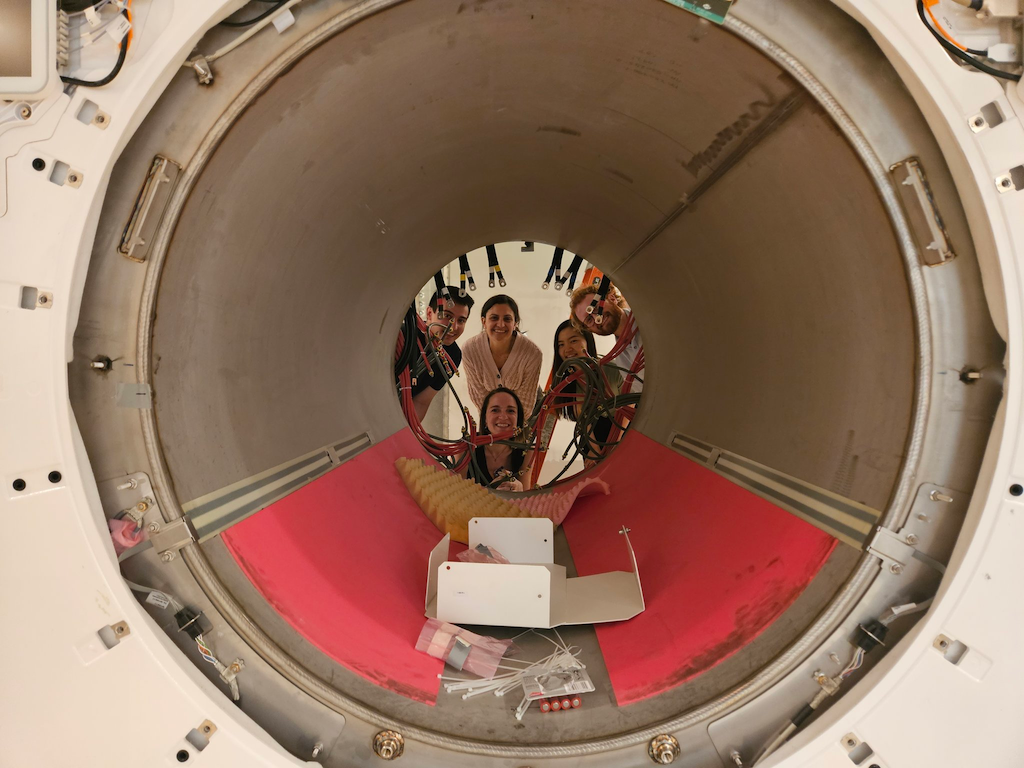CALL FOR APPLICATIONS: LINC FELLOWS

The center for Large-scale Imaging of Neural Circuits (LINC) is a multi-institutional consortium funded by the NIH BRAIN Initiative CONNECTS program to collect and analyze imaging data that will allow us to probe connections in the human and non-human primate brain at unprecedented resolutions.
As an NIH BRAIN Initiative funded project, the LINC center is implementing a Plan to Enhance Diverse Perspectives, with the goal of engaging promising junior researchers from diverse backgrounds and/or under-resourced institutions in our cutting-edge imaging and neuroscience research. We seek to name two undergraduate students and two postdocs “LINC fellows” for the academic year 2024-25.
The LINC center
Many brain-related disorders are now understood to originate not in a single brain area, but in how different brain areas are connected and communicate with each other. Remarkably, to date we do not have a complete picture of brain connections in their full complexity. The LINC center aims to develop cutting-edge image acquisition and analysis techniques that will allow us to map the wiring of the brain at much higher resolutions than ever before. We will then use these maps to advance our understanding of brain circuits that are implicated in motor and psychiatric disorders, and that are targeted by deep-brain stimulation to treat these disorders. In particular, we are aiming to reconstruct highly detailed maps of the cortico-subcortical pathways that connect the motor, premotor, and prefrontal cortex to the subthalamic nucleus.
The LINC center is among the only 1.5% of multi-PI projects funded by the BRAIN Initiative that have an all-female multi-PI team (source: BRAIN Initiative demographics FY14-FY22). We strive to enhance the diversity of our investigative team along all axes.
Research teams
Each LINC fellow will be embedded within one of our investigational teams:
- Circuits team: The circuits team is seeking fellows with a background in basic or clinical neuroscience or neuroanatomy. Postdoctoral applicants should be pursuing research in brain circuitry or network analysis; undergraduate applicants should be interested in gaining experience in this area. The LINC circuits team aims to define the pathways involved in deep-brain stimulation (DBS) of the subthalamic nucleus; annotate these pathways using anatomic tracing in non-human primates (NHPs), as well as novel microscopy and diffusion MRI tractography techniques in both NHP and human; and study the role of these pathways in DBS patient outcomes.
- Computational team: The computational team is seeking fellows with a background in biomedical or computer engineering or computer science. Postdoctoral applicants should be pursuing research in medical image analysis; undergraduate applicants should be interested in gaining experience in this area. The LINC computational team aims to develop pipelines for pre-processing of imaging data; registration across sections, modalities, and brains; segmentation of axons in microscopy images; multi-scale tractography; cross-validation of axon bundles between modalities; sharing and remote interaction with the data.
- MRI team: The MRI team is seeking fellows with a background in physics or engineering. Postdoctoral applicants should be pursuing research in MRI physics or engineering, biophysical modeling, or image reconstruction; undergraduate applicants should be interested in gaining experience in this area. The LINC MRI team aims to develop and deploy diffusion and structural MRI protocols for ex vivo imaging of NHP and human brains, and in vivo imaging of patients; implement MR image reconstruction algorithms to minimize artifacts; and develop methods for forward and inverse mapping between axonal microstructure and diffusion MRI signals.
- Optical microscopy team: The optical microscopy team is seeking fellows with a background in physics or engineering. Postdoctoral applicants should be pursuing advanced training in optical design, microscopy, instrument control, automated image acquisition, visualization and analysis; undergraduate applicants should be interested in gaining experience in this area. The LINC optical microscopy team aims to design, build, and test platforms for whole-hemisphere polarization-sensitive optical coherence tomography (PS-OCT) with multiple illumination angles, and for rapid, spectrally multiplexed 3D single-objective light-sheet microscopy (LSM); integrate PS-OCT with LSM for imaging of fluorescent tracers in NHPs; develop protocols for clearing, immunolabeling, and LSM of cut sections; collect PS-OCT/LSM data from NHP and human brains.
- X-ray microscopy team: The X-ray microscopy team is seeking fellows with a background in physics or engineering. Postdoctoral applicants should be pursuing research in X-ray image physics, X-ray sample preparation, phase-contrast imaging, or tomographic image reconstruction and analysis; undergraduate applicants should be interested in gaining experience in this area. The LINC X-ray microscopy team aims to test, optimize, and deploy protocols for hierarchical phase-contrast tomography (HiP-CT) in human brains; collect multi-scale HiP-CT data from intact brains; collect HiP-CT at even higher resolution in samples excised from the area of the subthalamic nucleus; perform osmium staining and micro-CT in the excised samples to validate the HiP-CT contrast.
The LINC fellows program
We are seeking two undergraduate students and two postdocs to serve as LINC fellows for the year 2024-25. We invite applicants from institutions with limited research resources, regardless of geographic location. The applicants are expected to have a research mentor in their home institution, who will provide a letter of support for their application. During the LINC fellowship year, the LINC fellows are expected to remain in their current program/institution, and to be engaged in a research project that can benefit from remote access to the data and computational resources of the LINC project, and collaboration with the LINC investigative team. Remote fellows will be “embedded” within one of the LINC teams virtually for a year, and will travel to Boston for a 5-day visit.
The fellows will attend regular LINC team virtual meetings, gain access to the cloud-based computational platform of the LINC project, and work on a project that makes use of LINC imaging data. Undergraduates will complete a senior thesis project, and postdocs will conduct a project related to their ongoing research. Depending on the academic background and research interests of each fellow, projects might have a neuroscience, computational, or engineering focus. Fellows will be embedded into the team that best fits their focus. We will support LINC fellows to publish their results and/or to participate in team publications as appropriate. We will further assist them with career planning and encourage them to build long-term collaborations and mentoring relationships with our team members.
We welcome the applicants’ own ideas for research topics, and we will further work with them to develop these topics. Examples of research projects include (but are not limited to):
- Studying the organization of specific fiber pathways in the brain
- Studying brain vasculature or other structures, in relation to fiber pathways
- Implementing and testing image registration, segmentation, or tractography algorithms
- Implementing and testing tools for cloud-based visualization, annotation, and proof-reading
- Developing annotated training datasets to train and benchmark machine-learning algorithms
- Developing engineering solutions to improve image analysis, e.g., designing holders that provide fiducial markers compatible with multiple imaging modalities and can aid image registration.
Eligibility
Undergraduate students must be within two years of finishing their undergraduate degree when the program begins. Postdoctoral fellows must have completed at least one year of postdoctoral research before the program begins. Both undergraduates and postdocs must be affiliated with their current home institution for the duration of the program. We place an emphasis on recruiting candidates who enhance the diversity of the LINC research team, as defined by the BRAIN Initiative PEDP. This includes, for example, women, underrepresented minorities, and candidates whose home institution is minority-serving or located in a low- or middle-income country.
How to apply
Both of the forms below must be submitted no later than August 16th, 2024. Applications will be reviewed on a rolling basis.
- Application form: Must be completed by the applicant.
- Letter of support form: Must be completed by the research mentor from the applicant’s home institution.
Questions?
If you or your mentee is interested in applying to the LINC fellows program, and you have questions about eligibility, potential projects, etc., please use the form below to contact us.
